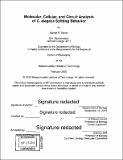| dc.contributor.advisor | H. Robert Horvitz. | en_US |
| dc.contributor.author | Sando, Steven R. | en_US |
| dc.contributor.other | Massachusetts Institute of Technology. Department of Biology. | en_US |
| dc.date.accessioned | 2020-09-25T20:03:47Z | |
| dc.date.available | 2020-09-25T20:03:47Z | |
| dc.date.copyright | 2020 | en_US |
| dc.date.issued | 2020 | en_US |
| dc.identifier.uri | https://hdl.handle.net/1721.1/127711 | |
| dc.description | Thesis: Ph. D., Massachusetts Institute of Technology, Department of Biology, 2020 | en_US |
| dc.description | Cataloged from the PDF of thesis. Vita. | en_US |
| dc.description | Includes bibliographical references. | en_US |
| dc.description.abstract | To identify the neural and molecular substrates of animal behavior and understand the principles by which they function is a major goal in neurobiology. One simple system for such behavioral studies is the pharynx of the nematode worm C. elegans, which contracts rhythmically (pumps) to ingest food. The connectivity (connectome) of the 20 pharyngeal neurons has been completely determined, making the pharynx one of the anatomically simplest and best-defined neuromuscular systems known to science. Previous work showed that ultraviolet (UV) light interrupts and modulates the pharyngeal pumping rhythm. This modulation requires the gustatory receptor orthologs lite-1 and gur-3. Because lite-1 and gur-3 control a similar pharyngeal response to hydrogen peroxide, the pharyngeal response to light was proposed to be a gustatory response to noxious chemical products of photooxidation (Bhatla and Horvitz, 2015). | en_US |
| dc.description.abstract | Here, we report that UV light induces a novel pharyngeal behavior: the spitting of the pharyngeal contents from the pharynx. Using this behavior as a model to study how a simple nervous system encodes an inversion of function (i.e., switching from feeding to spitting), we identified biomechanical mechanisms of and neural circuitry for spitting. Spitting results from the sustained contraction of pharyngeal muscles pml, pm2, and/or pm3. This contraction opens the food-trapping pharyngeal valve that normally captures food during feeding, resulting in spitting. Spatially restricted calcium increases in pml, pm2, and/or pm3 colocalize with the site of contraction. As reported previously (Bhatla et al., 2015), spitting requires the M1 pharyngeal neuron, which directly innervates pml, pm2, and pm3. M1 responds to UV light with calcium increases, and activation of M1 produces spitting. UV light-induced spitting requires lite-1 and gur-3. | en_US |
| dc.description.abstract | gur-3 functions in the 12 and 14 pharyngeal neurons and at least one other undetermined location to produce M1-dependent spitting. We propose that M1 acts as a functional hub for spitting, upon which multiple other neurons in the pharyngeal nervous system converge. Our work identifies a simple motif that controls an inversion of behavioral function and suggests that the M1 neuron is an important point of control in the pharyngeal network. | en_US |
| dc.description.statementofresponsibility | by Steven R. Sando. | en_US |
| dc.format.extent | 152 pages | en_US |
| dc.language.iso | eng | en_US |
| dc.publisher | Massachusetts Institute of Technology | en_US |
| dc.rights | MIT theses may be protected by copyright. Please reuse MIT thesis content according to the MIT Libraries Permissions Policy, which is available through the URL provided. | en_US |
| dc.rights.uri | http://dspace.mit.edu/handle/1721.1/7582 | en_US |
| dc.subject | Biology. | en_US |
| dc.title | Molecular, cellular, and circuit analysis of C. elegans spitting behavior | en_US |
| dc.type | Thesis | en_US |
| dc.description.degree | Ph. D. | en_US |
| dc.contributor.department | Massachusetts Institute of Technology. Department of Biology | en_US |
| dc.identifier.oclc | 1196086025 | en_US |
| dc.description.collection | Ph.D. Massachusetts Institute of Technology, Department of Biology | en_US |
| dspace.imported | 2020-09-25T20:03:45Z | en_US |
| mit.thesis.degree | Doctoral | en_US |
| mit.thesis.department | Bio | en_US |
